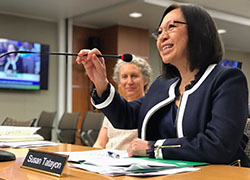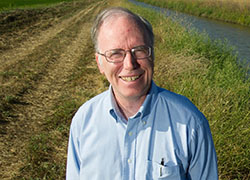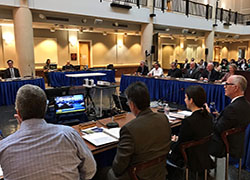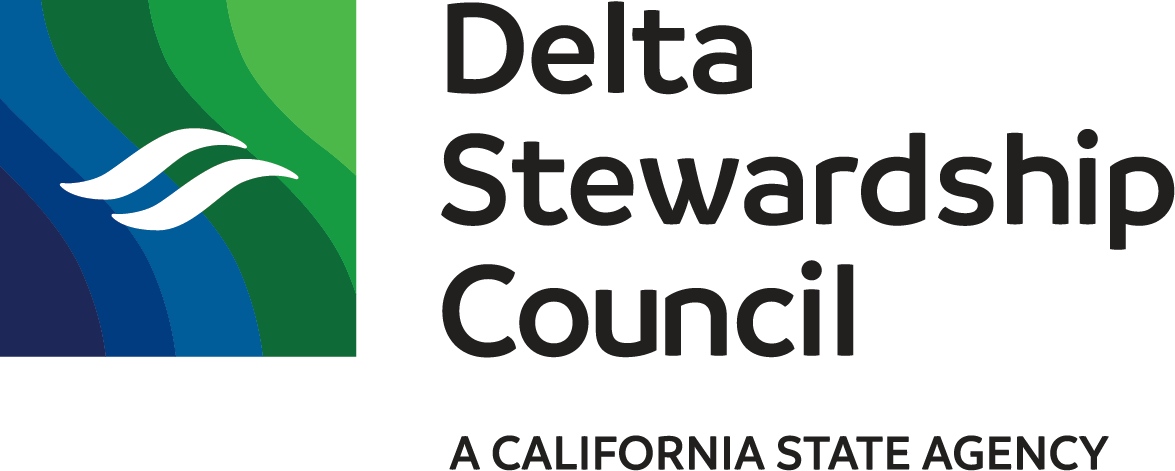
California water expert and Delta Independent Science Board member Jay Lund (pictured standing in the Yolo Bypass near West Sacramento) recently shared his thoughts with Delta Stewardship Council Chair Susan Tatayon about improving interagency collaboration in the Delta, potential applications for new monitoring technologies, forecast science, and more. Photo: Karin Higgins/UC Davis
On Science and Management in the Delta: A Conversation with Water Expert Jay Lund
May 30, 2019
By Susan Tatayon
I recently sat down with California water expert and Delta Independent Science Board (ISB) member Jay Lund to talk about some of the challenges and opportunities for scientists and decision-makers in the Sacramento-San Joaquin Delta. I am pleased to share highlights from our conversation in this month’s Delta Stewardship Council Chair’s blog.
Our conversation followed the Delta ISB’s recent letter to the Delta Plan Interagency Implementation Committee (DPIIC) calling for a bolder, forward-looking, and better-integrated science and management program that would provide policymakers and managers with better scientific information and management options for the Delta. DPIIC is the group of leaders whose agencies have a role in implementing the policies and recommendations in the Council’s Delta Plan.
During its most recent meeting, DPIIC endorsed several recommendations from the Delta ISB’s letter, including the creation of a science funding and governance workgroup to align science, management, and funding efforts in the Delta. My conversation with Jay Lund explores additional comments and recommendations from the Delta ISB as well as challenges and opportunities ahead.
Tatayon: In a letter to DPIIC earlier this year, the Delta ISB urged that we take advantage of rapidly changing technology to meet policy goals and to support management strategies. What are some examples of this technology and its application?
Lund: It is a lot easier to collect data now than it used to be. The Delta ISB recently saw this during a tour of the Central Delta. We have a lot of data collection going on by many different agencies and some of this monitoring has a long history.
It is so much easier now to add new sensors to existing monitoring stations. For example, combining hydrologic, chemical, and biological monitoring together at a critical confluence to understanding how these variables are all functioning at any given moment…now that is an intriguing idea. We might be able to get more out of the money we spend on monitoring and data collection, more insight, both for a fundamental understanding of the Delta – how ecosystems and water quality work, as well as a better understanding of how to operate the Delta in real-time. This includes knowing when we open and close flow gates, how should we change the pumping rates, and reservoir releases.
We will never get rid of all of the uncertainty in the system, but if we can better organize and improve how we collect and assimilate data into our understanding. Using tools like computer models, we should be able to more tightly manage benefits for ecosystems and maybe even improve our water supply.
Tatayon: What are your thoughts on how we can make water quality and supply monitoring more cost-effective, while still making sure we protect long-term monitoring sets?
Lund: When we have a long dataset, we hate to interrupt it. However, sometimes as we learn things, we do not need to collect as much of some data as we used to.
It is a bit like a recipe that you know really well. Once you have the recipe down, you can make it more by feel. You do not need to measure as carefully as before.
I think the same is true for some aspects of the Delta. Once we learn certain things, we should consider reorienting our investigative efforts away from things that we already know about the Delta system and towards things that we do not know that are important to figure out.
There are certainly long-term trends that we want to keep monitoring, but we cannot invest everything in traditional monitoring. Instead, we need to invest in new monitoring, integration, and synthesis towards a cohesive understanding of the system as a whole.
Permitting continues to be a barrier for these types of monitoring projects, however.
Tatayon: What does forecast science - the idea of predicting what’s to come - look like for the Delta science community? How does this fit in with exploratory science?
Lund: Rather than taking a shortsighted view of what happened one or five years ago, most agency actions and investments are for the future. The Delta system is undergoing a tremendous amount of change, from sea-level rise to rising temperatures, new invasive species, and droughts. In response to these rapid and more extreme changes, decision-makers are drafting policy and regulations and agencies are designing and engineering solutions.
Our estimates of how well actions will work will never be 100 percent reliable, but the likelihood of our solutions working depends on our ability to explore and consider a range of forecasts, rather than looking at one or two examples from the past.
Tatayon: A recent report from the Intergovernmental Science-Policy Platform on Biodiversity and Ecosystem Services* warns that nature is declining globally at rates unprecedented in human history, and the rate of species extinctions is accelerating. What do you think this means for the Delta?
Lund: I think this has been the case in the Delta for a long time. The native ecosystem of the Delta has been disappearing since the 1800s when it was diked and drained. Hydraulically it has been changing since water users upstream built dams and began diverting water for irrigation in the 1900s. We have further altered the system with levees, agriculture, eliminating seasonal wetlands, and other modifications.
I think we need an integrated, scientific look at how all of these changes are affecting the Delta and how they are likely to continue to affect the Delta in the future. This includes understanding likely outcomes of different scenarios and the variation between them.
Tatayon: Do you think we are asking the right management questions for the future of the Delta?
Lund: There is a range of future Deltas that we can manage for, though some changes will overwhelm our ability to manage the Delta in important ways. We cannot hold back the sea, for example. However, perhaps the most important question we should ask is what kind of Delta do we want in the future? The answer to this question should always involve the public and stakeholders, no matter how difficult it will be to form a consensus.
Historically, the Delta and California’s water have always been changing and scientists, administrators, and policymakers must be forward-looking in their actions. The State of California also has the inherent responsibility of caring for the future of the Delta. It behooves the agencies of the state, perhaps with the federal government, to organize how the future of Delta science will be organized and funded.
The path forward will not be easy, but effective water and ecosystem management depend on clear, coordinated action.
* A summary of the IPBES’ 2019 Global Assessment Report on Biodiversity and Ecosystem Services report for policymakers is available online. The full six-chapter report including all data will be published later this year.

About the Author
Susan Tatayon is Chair of the Delta Stewardship Council and has more than 30 years of experience in water resources policy, planning, and management. Her monthly blog shares updates about the direction of the Council, progress toward implementing the Delta Plan, and achieving the coequal goals of water supply reliability and restoring the Delta’s ecosystem.

About Jay Lund and the Delta Independent Science Board
Jay Lund is a member of the Delta Independent Science Board, which was created as part of the Delta Reform Act of 2009 to provide oversight of the scientific research, monitoring, and assessment programs in the Delta. He is also a professor of civil and environmental engineering and director for the Center for Watershed Sciences at UC Davis.

About the Delta Plan Interagency Implementation Committee
The Delta Reform Act of 2009 charged the Delta Stewardship Council to establish and oversee a committee of agencies responsible for implementing the Delta Plan. The Council established DPIIC after adoption of the Delta Plan in 2013 and continues to coordinate and oversee its activities as required by the Delta Reform Act.

